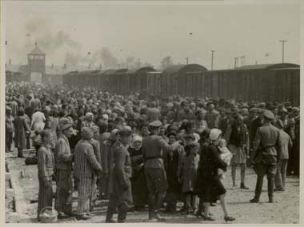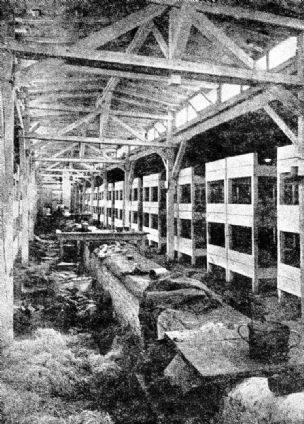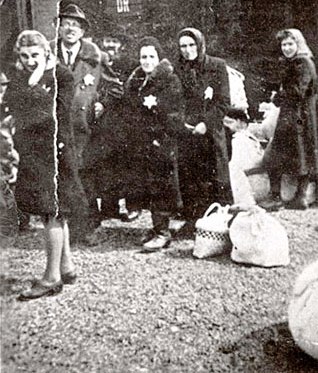The Sonderkommando Uprising, October 7th, 1944 – 80 Years – Part 1
By: Yaakov Rosenfeld, Ganzach Kiddush Hashem
A Scar in the Heart of the World
The events of October 7th, 2023 happened exactly one year ago. The horror that took place then is a scar in the heart of the whole world, and there are no words to express it.
Who would have believed that today, in a generation in which there are still living Holocaust survivors, Israel would be moved by a tragedy of this magnitude? Who could have imagined that nowadays such a massacre would take place in broad daylight?
However, although it is clear that this horror should not be compared to the Holocaust, because there is nothing equal to the Holocaust in the history of mankind, many, especially those whose memory of the Holocaust is burned into their lives and the lives of their families, did see a great similarity between the monstrous acts of the radical Muslims and those of the satanic SS Nazis. The feeling, in light of the dark passions that came to the fore on that Simchat Torah morning last year, was established even in the hearts of the most extreme left-wing peace-seekers, that it is the abysmal hatred of Jews that dictates the level of murderous Satanism of the children of Yishmael (the Muslims) and not, as they imagined, a territorial struggle or an uprising of an oppressed people who aspire to freedom.
And so, on the day when the whole world will mark the anniversary of the heinous murder that took place within the Jewish state, we at Ganzach Kiddush Hashem will also remember the terrible murder that took place in Birkenau on October 7th, the night of Hoshana Raba in the year 5705 (1944), exactly eighty years ago.

A selection in Auschwitz
In the world, specific events that occurred in the Holocaust are not usually pointed out, even though similar events that occurred in other periods were given a much wider and fundamental place in history and in the books that describe it. For example, I will take the Kishinev (Chisinau) atrocities that took place during the Holocaust and are almost unknown, even though they were a thousand times worse than the Kishinev Pogrom that happened forty years earlier and their details are known to many, and are even recorded in the history books.
The Holocaust is burned in hearts, forever, as a long and protracted decree during which six million were slaughtered – a third of the Jewish People. This fact is too traumatic to go into its details, events and exact dates. For this reason, also, the “seventh of October” 1944 is a date that is almost unknown. This is apart from the other, general reason for the lack of public interest in this or that date, which is that, unfortunately, there were almost no survivors of the Holocaust (in relation to the number of victims) and its main events, and there was no one to mark them as they and their descendants used to mark the other historical tragedies.
The Night of Hoshana Raba 5705 (1944)
Despite this, it seems that the events of October 7th, 1944, the night of Hoshana Raba 5705, in Auschwitz-Birkenau, are out of the ordinary. Therefore, in view of the valuable material found in various places about some of the leaders of the rebellion, holy and pure Jews who kept diaries in the Valley of the Shadow of Death and wrote valuable documentation about those bitter days, when the Jews of Hungary and Czechoslovakia were being wiped out, precisely in the twilight of the war, when the Allied forces were already on the verge of victory – let us plunge into the darkness of that black night and reflect a little on the heroism and holiness of heartbroken Jews who remained isolated from all their family members and everyone they knew, and thus, with a black hole of grief and sighing, sanctified the Name of G-d in their lives and deaths, and did not lose their G-dly image both in the hell of Auschwitz and while standing on the brink of an abyss.
The Sonderkommando was the most guarded group in Auschwitz, and the only ones who came into contact with the prisoners who were sent to the gas chambers upon disembarking the trains. Its duties were clearing the gas chambers, collecting the belongings and items of the victims, and burning the bodies in the crematoria.

The interior of the Sonderkommando’s barrack in the Birkenau camp
The group, at its peak, in 5704 (1944), numbered over a thousand prisoners, Jews from Greece and Poland. There was almost no survivors left among the Sonderkommandos. The Nazis would execute them every so often. Indeed, before the SS men threw them into the gas chambers too, sometimes after the end of “dealing with” a large shipment of Jews, the Sonderkommandos were given much improved conditions than the other prisoners. They received a lot of food and could enjoy the spoils left by those murdered.
Their role was impossible, and clearly inhumane. They were forced to perform disturbing tasks. Just imagine the shock of a man who arrived by train with his loved ones – his wife and children – and after less than a day he is standing over their corpses and having to deal with their limbs, sometimes – to pull out the gold teeth in their mouths… Therefore, it was known that the Sonderkommando men were neither respected nor admired. They wore an animalistic look and worked almost automatically, without thinking and without delving deeply. This was what was thought, at least until the discovery of the manuscripts of some of these men, Jews from the Sonderkommando who met their deaths during the uprising of October 7th, 1944. The manuscripts of three holy Jews from the organizers of the uprising shed some light, as far as that word can be used in this situation, on the period and their mindset.
In fact, from a study of the materials and books of the time, those that have won the trust of the historians and the survivors of Auschwitz and Birkenau, we have learned that the mocking accusation that those who were burned “went like sheep to the slaughter,” which for many years was the claim of many of those who were not “there” and did not understand what the Auschwitz prisoners faced, is pure nonense, since every attempt of uprising and rebellion, and there were countless such, were immediately met with brutal slaughter both of those involved in the “conspiracy” and of their innocent friends and neighbors.
The Uprising and Its Downfall
Such was also the result of the uprising in question, which took place on October 7th, 1944. Not even one of the Sonderkommando resisters survived, and without the important discovery of their hidden manuscripts, we would know nothing about these people today.
Plans for an uprising in Auschwitz Birkenau had already begun to take shape during the year 1943 (5703). An organization called Kampfgruppe Auschwitz was established and a group from the Sonderkommando took part in this group.
At the beginning of October, worry began to gnaw at the hearts of the Sonderkommandos. The shipments from Hungary stopped and logic said that in the near future their end would also come, since there was no longer any need for them. At the same time, their situation was greatly eased because the sadistic commander of the crematoria, Moll – may his name be blotted out – was returned to Germany and Hermann Buch was appointed in his place. Buch who was a hedonist and a drinker and was less concerned than his predecessor with supervising and torturing the prisoners.

Hungarian Jews arriving in Auschwitz
At that time, 663 people served in the Sonderkommando in Birkenau, according to this division: 169 people in crematoria 2, 3 and 4, and in crematoria 5 – 156 people. This number was lower than usual, since in September 1944 (Elul 5704) the Nazis removed 200 Jews from the Sonderkommando and sent them to the gas chambers. This fact increased the motivation of those who remained alive. The rule that guided them was, according to the book of Tzal Mark, the saying of the Sages: “If not now, when?…”
Various plans were drawn up in secret and dates were chosen and rejected, until the lot fell on the 7th of October 1944. In the end, due to unclear reasons, of all the underground groups that were at the forefront of planning and organizing the rebellion, at the moment of truth, only the members of the Sonderkommando group remained. All the rest disappeared on the day of the order.
On the 7th of October, the leaders of the Sonderkommando gathered after reliable information reached them about the plans of the SS to eliminate them for good. The decision was made to revolt immediately. The weapon (most of which was obtained by Jewish female prisoners working at the Union factory) was taken out of the ground, and the attack began.
First the SS guards were attacked. Grenades were thrown into crematorium No. 4. At the same time, a Jewish hero from Lomza, named Panitz, grabbed the Oberkapo (head kapo) and threw him into the fire, others opened fire on the German guards, while others cut the electrified barbed wire and fled towards the community of Budy.
The sights of the battle and the burning fire made a great impression on the Auschwitz prisoners. Those who survived and wrote down their memories testified that the sight of the burning chimney, falling down and crashing on the blood-soaked ground, filled them with encouragement and hope.
The uprising, however, due to breaking out unexpectedly, did not go as planned. According to the plan, the signal was supposed to be given by crematorium No. 3 and then the rebellion would break out in 2, 3, 4 and 5, but in the end, no action took place in crematoriums 3 and 5.
Meanwhile, the SS men came to their senses and took control of the “commando” of Sonderkommando No. 3 and imprisoned them all in the hall where the German doctors operated on prisoners. At the same time, the SS leadership summoned reinforcements of about 3,000 military personnel armed with sophisticated weapons, so that the balance of forces was clearly in their favor, and those among the rebels who did manage to escape to the Vistula River, a distance of 8 km, were captured by the Nazis and shot dead. In the end, the uprising failed, and the majority of the 663 Sonderkommando members were killed in the difficult, hopeless battles.
To be continued.
In the next segment: About the four female heroes who provided explosives for the uprising, and were captured and brutally tortured, but did not provide even a shred of information about their brothers and sisters, and finally were publicly hung and died in sanctification of G-d’s Name.
As well, the next segment will present the heart-wrenching diaries discovered in the ruins of Auschwitz. Three diaries written by the participants of the uprising, G-d fearing Jews of faith, among them the “Dayan (rabbinical judge) of Makow” the holy Rabbi Leib Langfus.












